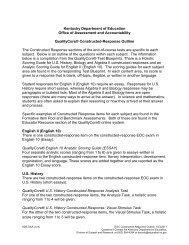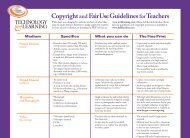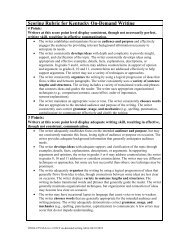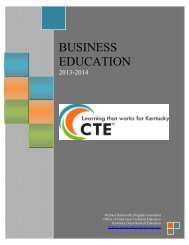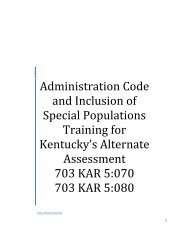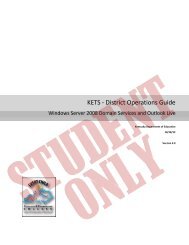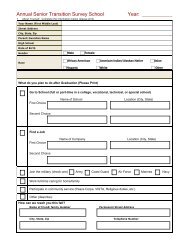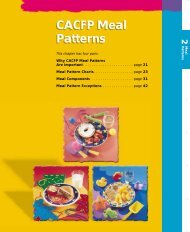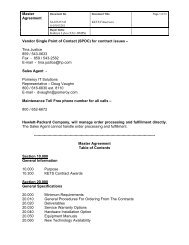Standards with Progressions grades K-HS v. 1.3 - Kentucky ...
Standards with Progressions grades K-HS v. 1.3 - Kentucky ...
Standards with Progressions grades K-HS v. 1.3 - Kentucky ...
- No tags were found...
Create successful ePaper yourself
Turn your PDF publications into a flip-book with our unique Google optimized e-Paper software.
Domains<br />
Clusters<br />
Mathematical<br />
Practices<br />
<strong>HS</strong> Conceptual Category: Number and Quantity<br />
The Real Number System Quantities The Complex Number System Vector and Matrix Quantities<br />
Extend the properties of<br />
exponents to rational<br />
exponents<br />
Use properties of rational<br />
and irrational numbers.<br />
17. Make sense of problems and<br />
persevere in solving them.<br />
18. Reason abstractly and<br />
quantitatively.<br />
Reason quantitatively and<br />
use units to solve problems<br />
Perform arithmetic operations <strong>with</strong><br />
complex Numbers<br />
Represent complex numbers and their<br />
operations on the complex plane<br />
Use complex numbers in polynomial<br />
identities and equations<br />
19. Construct viable arguments and 21. Use appropriate tools strategically.<br />
critique the reasoning of others. 22. Attend to precision.<br />
20. Model <strong>with</strong> mathematics.<br />
Represent and model <strong>with</strong> vector<br />
quantities.<br />
Perform operations on vectors.<br />
Perform operations on matrices and use<br />
matrices in applications.<br />
23. Look for and make use of<br />
structure.<br />
24. Look for and express regularity in<br />
repeated reasoning.<br />
Numbers and Number Systems. During the years from kindergarten to eighth grade, students must repeatedly extend their conception of number. At first, number‖ means<br />
―counting number‖: 1, 2, 3... Soon after that, 0 is used to represent ―none‖ and the whole numbers are formed by the counting numbers together <strong>with</strong> zero. The next extension is<br />
fractions. At first, fractions are barely numbers and tied strongly to pictorial representations. Yet by the time students understand division of fractions, they have a strong concept of<br />
fractions as numbers and have connected them, via their decimal representations, <strong>with</strong> the base-ten system used to represent the whole numbers. During middle school, fractions are<br />
augmented by negative fractions to form the rational numbers. In Grade 8, students extend this system once more, augmenting the rational numbers <strong>with</strong> the irrational numbers to<br />
form the real numbers. In high school, students will be exposed to yet another extension of number, when the real numbers are augmented by the imaginary numbers to form the<br />
complex numbers .With each extension of number, the meanings of addition, subtraction, multiplication, and division are extended. In each new number system—integers, rational<br />
numbers, real numbers, and complex numbers—the four operations stay the same in two important ways: They have the commutative, associative, and distributive properties and<br />
their new meanings are consistent <strong>with</strong> their previous meanings. Extending the properties of whole-number exponents leads to new and productive notation. For example, properties<br />
of whole-number exponents suggest that (51/3)3 should be 5(1/3)3 = 51 = 5 and that 51/3 should be the cube root of 5. Calculators, spreadsheets, and computer algebra systems can provide<br />
ways for students to become better acquainted <strong>with</strong> these new number systems and their notation. They can be used to generate data for numerical experiments, to help understand<br />
the workings of matrix, vector, and complex number algebra, and to experiment <strong>with</strong> non-integer exponents.<br />
Quantities. In real world problems, the answers are usually not numbers but quantities: numbers <strong>with</strong> units, which involves measurement. In their work in measurement up through<br />
Grade 8, students primarily measure commonly used attributes such as length, area, and volume. In high school, students encounter a wider variety of units in modeling, e.g.,<br />
acceleration, currency conversions, derived quantities such as person-hours and heating degree days, social science rates such as per-capita income, and rates in everyday life such<br />
as points scored per game or batting averages. They also encounter novel situations in which they themselves must conceive the attributes of interest. For example, to find a good<br />
measure of overall highway safety, they might propose measures such as fatalities per year, fatalities per year per driver, or fatalities per vehicle-mile traveled. Such a conceptual<br />
process is sometimes called quantification. Quantification is important for science, as when surface area suddenly ―stands out‖ as an important variable in evaporation.<br />
Quantification is also important for companies, which must conceptualize relevant attributes and create or choose suitable measures for them.<br />
<strong>Kentucky</strong> Department of Education<br />
52 | P a g e




